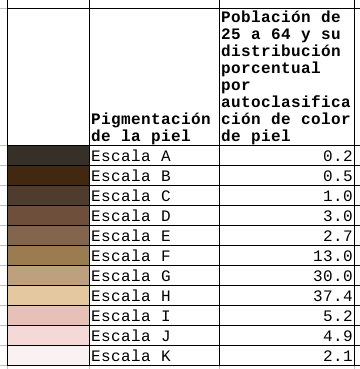
The Intergenerational Social Mobility Module (MMSI) can be seen as a stage in a series of efforts that have attempted to address discrimination and racism in Mexico using quantitative methods. This is evident in the 2005 and 2010 National Surveys on Discrimination (ENADIS), respectively. These instruments were managed by CONAPRED (National Council for the Prevention of Discrimination) and the Secretariat of Social Development. They came to fruition during the administration of Vicente Fox, who at the time represented the alternative to the Institutional Revolutionary Party and who created entities such as INALI (National Institute of Indigenous Languages) or CDI (National Commission for the Development of Indigenous Peoples).
Quantitative studies exploring practices of discrimination and racism in the country emerged five years after the Zapatistas’ March for the Color of the Earth, four years after the Durban Conference, which was attended by Gilberto Rincon, who founded the Commission for the Study of Citizens against Discrimination, a body that would later become CONAPRED, and Rodolfo Lara Ponte, then the fourth commissioner of the National Human Rights Commission (CNDH).
Lexico-statistics as a tool to highlight racial inequality
Since the National Survey on Discrimination (ENADIS) of 2005, terms such as "culture of discrimination" or "racial characteristics" have been used to identify which people have been discriminated against "because of their condition", that is, being indigenous, black, migrant, homosexual, etc. In this study, it was noted that 34.1% of the people surveyed thought that, for indigenous people to leave poverty behind, what they needed to do was to stop behaving like an indigenous person. That is, the use of terms such as "culture of discrimination" or "condition" attributed discrimination to a habitus or "behaviour", while also making invisible the role played by skin colour in racism.
The use of these terms prevailed in the ENADIS 2010 and was part of a wider project to nationalize an anti-discriminatory agenda and to harmonize this with the legislative field. However, despite the fact that CONAPRED’s budget had been increased between 2010 and 2015, and that a Federal Law to Prevent Discrimination was passed in 2003, CONAPRED did not have the political clout to make its anti-discriminatory proposals effective.
Some months after the Intergenerational Social Mobility Module was published, CONAPRED announced the results of its National Survey to Prevent Discrimination 2017. This survey went deeper into issues such as prejudice, stigma and stereotype, in addition to emphasizing the structural character of discrimination. This directed attention to other bodies such as the Economic Commission for Latin America and the Caribbean and to talk more holistically about the practices around "privilege" that fostered growing inequality in the country. In sum, the use of racial categories, combined with other factors related to inequality, made it possible to show how Mexicans rank people and how racial factors operate in an intersectional manner.
THE INTERGENERATIONAL SOCIAL MOBILITY MODULE
On June 16, 2017, National Institute of Statistics and Geography (INEGI) presented for the first time, within the framework of the National System of Statistical and Geographic Information (SNIEG), the results of the Social Mobility Module Intergenerational (MMSI) 2016, which was based on the statistical design of the National Household Survey (ENH).
The study focused on 4 dimensions:
- Education level
- Occupational level
- Wealth
- Perception
And the following socio-demographic characteristics:
- Age
- Sex
- Place of residence
- Size of the home
- Relationship
- Marital status
- Indigenous language
- Racial origin
In the background documents of the Survey (Press Release, Main Results and Methodological Note), terms such as ethnic or racial belonging, skin colour, race or ethnic self-ascription (Asian, black, mulatto, white, mestizo and indigenous) are used interchangeably.
And a chromatic scale was used with a skin colour classification, which was taken from the one used by the Project on Ethnicity and Race in Latin America (PERLA). This chromatic scale used included 11 skin tones , being "A" the darkest and "K" the whitest, with the idea that interviewees would identify their own shade of skin colour.
Opening the debate
Although the methodology and the terms used by INEGI have been discussed mainly by a certain sector of the academy (see Comunicado de la Red Integra respecto a la Encuesta sobre Movilidad Social Intergeneracional del INEGI, June 22, 2017), this Survey and the presentation of its results, opened up a debate on Mexican racism and its various narrative, practical and "common sense" expressions not only in academic sectors (Colegio de México, Red Integra, UNAM), but also among non-academics (civil society organizations such as CEPIADET) and in the media.
In general the Intergenerational Social Mobility Module Survey established correlations between the skin colour and the socio-economic and educational level of the people surveyed.
Another aspect of great importance is way the discussion developed. In general, two trends can be observed: the majority concluded that the results verified what was already common sense knowledge about how racism works in Mexico. And on the other hand, critics argued that the study itself was racist because it used the term "race" in the survey. In any case, what is irrefutable is that it has created a space for discussion and debate about racism in Mexico.
Between racial literacy and denial, the particularity of mestizaje
Some of the results of the Module process have been the following:
- An opportunity to discuss racism was opened up.
- The use of terms such as CROMATOCRACIA and PIGMENTOCRACIA was proposed.
- The importance of generating "literacy" about racism and the relevance of managing concepts such as "whiteness", "racialization" or "privilege" has been demonstrated.
- The use of the colour scale has aroused discontent in academic sectors, while it made sense for organizations and collectives as a way to explain the inequality they experience.
- The way in which the results of the MMSI have been communicated has had the effect of "distracting" from the most important issue: combating racism.
References
Instituto Nacional de Estadística y Geografía. Nota metodológica. Módulo de Movilidad Social Intergeneracional. 2016
Instituto Nacional de Estadística y Geografía. Principales resultados y bases metodológicas. Módulo de Movilidad Social Intergeneracional. 2016
Instituto Nacional de Estadística y Geografía. Comunicado de prensa núm. 261/17 Ciudad de México. 16 de junio de 2017

